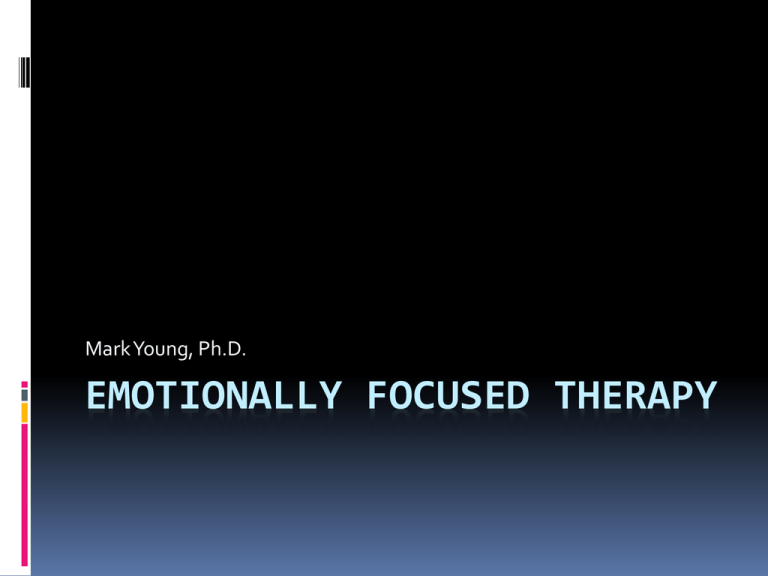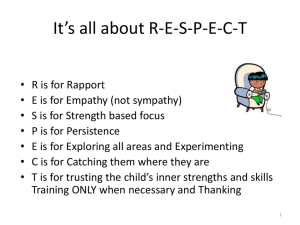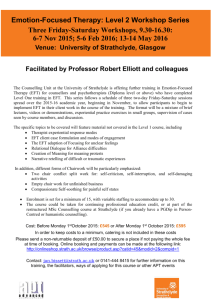EMOTIONALLY FOCUSED THERAPY Mark Young, Ph.D.
advertisement

Mark Young, Ph.D. EMOTIONALLY FOCUSED THERAPY Short-term Therapy Focus: We must understand theory We must understand change We must understand change events Founder & Key Figures Leslie Greenberg Susan Johnson EFT came from taping couples and watching how people change – finding what was important Strengths of EFT Clear, explicit conceptualization of relationship distress and adult love. Change strategies and interventions are specified. EFT is empirically validated. EFT has been applied to many different kinds of problems and populations. View of distress Relationship distress is maintained by absorbing negative affect. Affect reflects and primes rigid, constricted patterns of interaction. Patterns make safe emotional engagement difficult and create insecure bonding. Marital Distress High levels of negative affect: Absorbing states more compelling than positive affect Gender differences in coping Negative attributions are the norm: Character blame Marital Distress Rigid repetitive interactional patterns: No exits – no detours/ repair impossible Rigid narrow positions – fight/flight/freeze Most common patterns Criticize, complain, express contempt Defend, distance, stonewall Results: self reinforcing cycles or reactivity/self protective strategies (individual safety first) Partners cannot attune to one another because they are so absorbed in their own negative affect Cannot communicate because of their own state. Gottman 1979 – absorbing states of negative affect: everything leads in, nothing leads out. Goals of EFT To expand and re-organize key emotional processes. To create a shift in partners’ interactional positions. To foster the creation of a secure bond between partners. Research 70 – 73% recovery rate in 10-12 sessions. Results stable – even under high stress. Depression significantly reduced. Variety of populations and settings. Best predictor of success – female faith in partner’s caring (Not initial distress level). Principles & Concepts Looks within at how partners construct their emotional experience of relatedness Looks between at how partners engage each other. Focus of EFT: The 4 P’s Experiential Present Primary Affect Systemic Process (time) Positions / Patterns The therapist is a process consultant 4 P’s Present experience Deal with the past when it comes into the present to validate client’s responses as it relates to how they coped/survived When emotion is re-experienced it is now in the present Focus is on current positions/patterns Don’t ask “why”, focus on what is. 4 P’s Primary emotions Validating and moving from secondary to primary emotions Stay with emotions, create safe haven Organize the emotion of a past experience so that client can engage in the here & now 4 P’s Process patterns Look individually how each person is processing in the moment “What happens…then what…then what” Positions The position each partner is taking in the relationship Work to create new position & new patterns 3 Tasks of EFT 1. Create and maintaining a therapeutic alliance. 2. Accessing and reformulating emotion. 3. Restructuring key interactions. Task 1 Interventions Therapeutic Alliance 1. Empathic Attunement 2. Acceptance 3. Genuineness 4. Continuous active alliance monitoring Task 2 Interventions Accessing and Reformulating Emotion Fostering an emotion focus Primary, secondary, instrumental emotions Key Issues when focusing on Emotion 1. Involvement: requires direct engagement and experience of the emotions. 2. Exploration: leads a process of emotional discovery based on personal experiences. 3. New emotion: discover and expand previously unrecognized or unformulated emotional experiences. Support engagement with primary emotions. Task 3 Interventions 1. Tracking & reflecting patterns & cycles of interactions 2. Framing and reframing problems in terms of negative cycles and attachment responses. 3. Using enactments to shape interactions (choreographing new events to modify, step by step, each partner’s position). Restructuring Interactions Enactments Used to shape and restructure interactions. 1. Enacting present positions 2. Turning new emotional experiences into new interactions. 3. Highlighting rarely occurring responses. Enactments Phase 1: Making the request to make contact Phase 2: Maintaining the focus, blocking detours, and containing and framing escalations Phase 3: Processing each partner’s experience of the enactment Skills for Emotional Engagement R-I-S-S-S-C R: The therapist intentionally REPEATS key words and phrases for emphasis. I: Therapist uses IMAGES or word pictures that evoke emotions more than abstract labels tend to do. S: Therapist frames responses to clients in SIMPLE and concise phrases. R-I-S-S-S-C S: Therapist will SLOW the process of the session and the pace of her speech to enable deepening of emotional experience S: Therapist will use SOFT and soothing tone of voice to encourage a client to deepen experience. C: Therapist uses CLIENT words and phrases in a supportive/validating way. Nine Steps of EFT Steps 1 – 4 Assessment & Cycle De-escalation 1. Alliance & assessment: Creating an alliance and delineating conflict issues in the core attachment struggle. What are they fighting about and how are they related to core attachment issues. Nine Steps of EFT Steps 1 – 4 Assessment & Cycle De-escalation 2. Identify the negative interaction cycle, and each partner’s position in that cycle. Goal is to see the cycle in action and then identify and describe it to the couple and work to stop it. Nine Steps of EFT Steps 1 – 4 Assessment & Cycle De-escalation 3. Access unacknowledged emotions underlying interactional positions. Goal is to help each partner to access and accept their unacknowledged feelings that are influencing their behavior. Both partners are to reprocess and crystallize their own experience in the relationship so that they can become emotionally open to the other person. Nine Steps of EFT Steps 1 – 4 Assessment & Cycle De-escalation 4. Reframe the problem in terms of underlying feelings, attachment needs, and negative cycle. The cycle is framed as the common enemy (externalizing the problem) and the source of the partner’s emotional deprivation and distress. Nine Steps of EFT Steps 5 – 7 Changing Interactional Positions and creating new bonding events 5. Promote identification with disowned attachment emotions, needs, and aspects of self, and integrate these into relationship interactions. Goal is to help the couple redefine their experiences in terms of their unacknowledged emotional needs. Nine Steps of EFT Steps 5 – 7 Changing Interactional Positions and creating new bonding events 6. Promote acceptance of the other partner’s experiences and new interactional responses. Goal is to work to get each partner to accept, believe, and trust that what the other partner is describing in terms of underlying emotional needs is accurate. Nine Steps of EFT Steps 5 – 7 Changing Interactional Positions and creating new bonding events 7. Facilitate the expression of needs and wants and create emotional engagement and bonding events that redefine the attachment between the partners. Goal is to help couple learn to express their emotional needs and wants directly and create emotional engagement. Nine Steps of EFT Steps 8 – 9 Consolidation/Integration 8. Facilitating the emergence of new solutions to old relationship problems. Without the old negative interaction style and with the new emotional connection and attachment, it is easier to develop new solutions to old problems. Nine Steps of EFT Steps 8 – 9 Consolidation/Integration 9. Consolidating new positions and new cycles of attachment behaviors. Help couple clearly see and articulate the old and new ways of interacting to help the couple avoid falling back into the old interactional cycle. Overview of Process Develop an alliance, identify cycle, identify and access underlying emotions, and work to deescalate 2. Engage the withdrawer 3. Soften the pursuer/blamer 4. Create new emotional bonding events and new cycles of interaction 5. Consolidate new cycles of trust, connection and safety, and apply them to old problems that may still be relevant 1.


